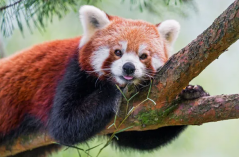小熊猫:森林中的“红色精灵”

Red pandas are not actually close relatives of the giant panda, belonging to their own unique family. They spend most of their lives in trees, eating, sleeping and sunbathing.
Red pandas live mainly in the high-altitude (2,500-4,000m) forests of the Eastern Himalayas. Brilliantly adapted against the cold and for life in the trees, red pandas grow to the size of a house cat. They’re between 56-62.5cm long without their tail, which is 37-47.2cm long. They weigh between 3.6-7.7 kg. They have rusty red fur, which matches the environment on the trees where they spend most of their lives. They also have a black belly that makes them hard to spot from below. In both cases, they are protected from predators.
What do red pandas eat? 95 per cent of their diet is bamboo. While giant pandas feed on most of the bamboo plant, red pandas go for the leaf tips and tender shoots alone. They eat massive amounts of it — up to 1.8kg every day. Along with bamboo, red pandas will sometimes tuck into fruit, roots, eggs, insects and small mammals.
___△___ Red pandas have thick tails, which they can use to warp around themselves when curled in a ball. Besides, they have two layers of fur, which enables them to cope with night time temperatures of as low as -7 degrees, and also stay dry in snowy conditions. If temperatures drop really low, red pandas can become dormant to conserve energy and wake up from this deep sleep every few hours to feed.
Red pandas can live up to 23 years, though typically up to 10 in the wild. But with fewer than 10,000 individuals left in the wild, red pandas are listed as Endangered on the IUCN Red List. They are threatened by loss of habitat as a result of both forest clearances and climate crisis, with higher temperatures forcing red pandas to higher altitudes. Forest fires and traps laid for animals such as deer and wild pigs are also a threat.
原创编写 版权所有 侵权必究! 每日更新 个性化阅读 英语飙升!